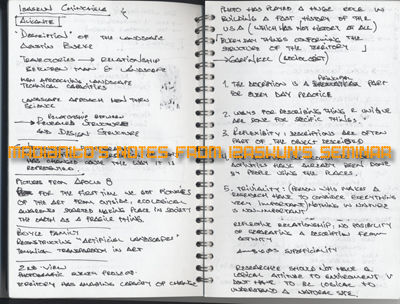
Sep '04 - May '12
So, since my last POSTS might give u the wrong impression of what im doing here...
(most of times i post stuff that has nothing to do with arch, because: i dunno u, but sometimes i get sick of thinking/talking about architecture so i need to think/write about something else like Real Madrid vs Barcelona, or BCN beach, BCN nightlife, etc, anyways...)
so, this post will show u how much stuff we (the researchers @ IAAC) are trying to get inside our brain, and maybe that way you all (readers of this trivial BLOG) can get focused on academics, architecture attitude, and blah blah blah...
(i found more interest in talking about "trivial" stuff -like the match of last night of Barcelona vs Milan, that i watched at a small neigborhood bar with a lot of Barca followers and i had such a good time, despite the fact that Barca lost-, maybe is just that im lately thinking architecture is trivial and we just make to much deal out of it)
Ok so, just a brief sample of what we've been doing here:
fall term 2004
Seminar 18-10-2004
INTRODUCTION TO LAND STRUCTURING AS AN ACT OF [TRAJECTIVE] DEVELOPING
tutor: IZASKUN CHINCHILLA
(first of all i would like u all to know i think Izaskun is kind of a young genius, that girl really amazes me, shes a very good teacher, who this year teaches at the same time @ Madrid, Alicante and Barcelona, besides having her own practice @ Madrid)
ok... academics!:
(first some selection of the enormous amount of ideas Izaskun has droped or made me think about)
-Trajectories are relationships between man and landscape
-Human aproach landscape thru technical capacities, and landscape aproaches humans thru science [¿?]
-Relationships between revealed structures and designed structures
-With contemporary photography the description and perception of land has changed because of the way is now represented.
-With the first pictures we got of the earth in its totallity (Apollo 8 pictures from outer space) a lot of things changed about the way we thought about the land (the planet) and social awareness of the ecological aspects started after watching the earth as a fragile thing.
-Modern american photographers played a huge role in building a (fast) history of the u.s.a. (place which lacked of a huge cultural or historical background) by shooting everyday things as the 'structure of the territory'
-A researcher should not have a logical attitude towards the comprehension of the enviroment and dont have to be logical to understand the natural enviroments.
-Recognize the structure of a landscape.
-Landscape is all opportunities that humans have to transform the place where they are living.
-Triviality: a person who makes a research have to consider everything very important, nothing in nature is 'non-important'
and now we are working/analizing/understanding the relationships, and differences of 7 different cases we have to analize to discuss them next session (monday):
+Case #1:
Inmediate inspiration signs, the photographic work of Andreas Gursky versus the power lines project by Martha Schwartz (executed in 1999 in Gelsenkirchen, Germany and comissioned by the International Building Exhibition Emscher Parky).
+Case #2:
Inmediate Inspiration signs (II), the 1982 Parc de la Villette competition (especifically the submissions by Rem and Tschumi), and the photographs of Stéphane Couturier.
+Case #3:
Inmediate inspiration signs (III), Yves Brunier and structure as quality texture.
+Case #4:
The structure of the agents involved, social oportunities for innovation. Reading applied to the land of The Structure of the Scientific Revolutions by Thomas Kuhn.
+Case #5:
Conservation structure, natural park legislation, the notion of nature's rights (Michel Serres) and the contemporary concept of the reserve.
+Case #6:
The conquest and mobilisation of the American West, trade expeditions and their means of registration.
+Case #7:
The political characterization of the periphery. (I) description: Robert Adams, Lewis Baltz, Xavier Ribas, Hill Owens.
+Case #8:
The political characterization of the periphery. (II) reconstruction:
Laurie Simmons, Gregory Crewdson, John Cheever's 'the swimmer', Neddy Carril's 'Lucinda River'.
and we will mention other 8 different cases next session too
also, mmhhh among all the bibliography she gave, im trying to read some parts of the text wich will be more helpfull for this stage of the course which are:
-Paris Ville Invisible (1988), by Bruno Latour, Les Empechers de penser en rond & La Decouverte.
-Secret Knowledge, by David Hockney (one of my favourite painting artists by the way).
-Contranatura, by Joan Fontcuberta
-Stefano Boeri's section in MUTATIONS (about the european territory).
mmhhhhh...what else???
oh yeah, an image:
JUST A SAMPLE OF GURSKY'S WORK
oh and also to show im also working and paying attention even if i had the worst "mediterranian" hangover:
...to be continued...
Tales and Adventures of my time at the IaaC when this was in it's early years. Feel free to contact me for more reference, in any case i would advice you to enroll here.
1 Comment
Well I said it before and say it again put attention to Izaskun, she is the most valuable of the lot.
Block this user
Are you sure you want to block this user and hide all related comments throughout the site?
Archinect
This is your first comment on Archinect. Your comment will be visible once approved.